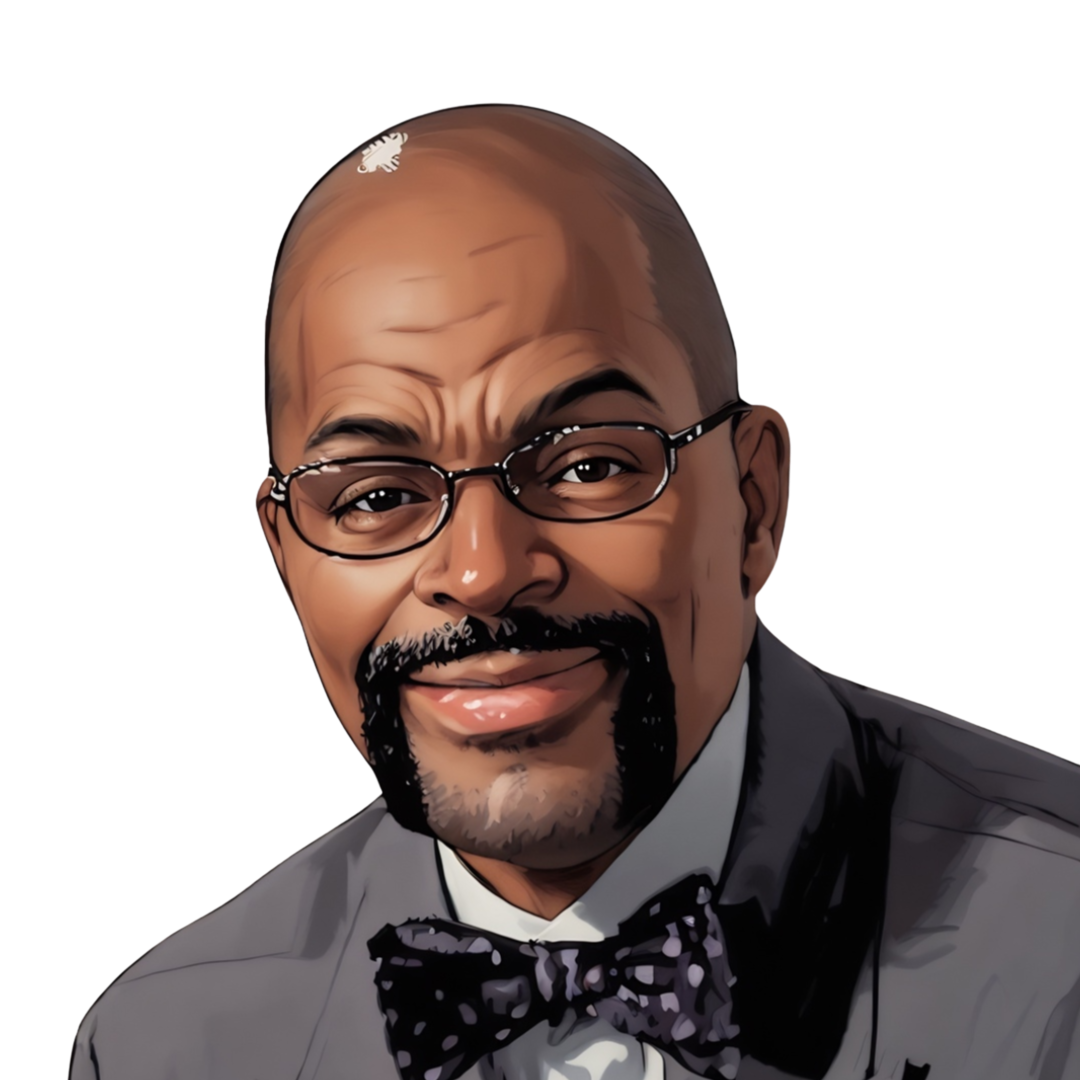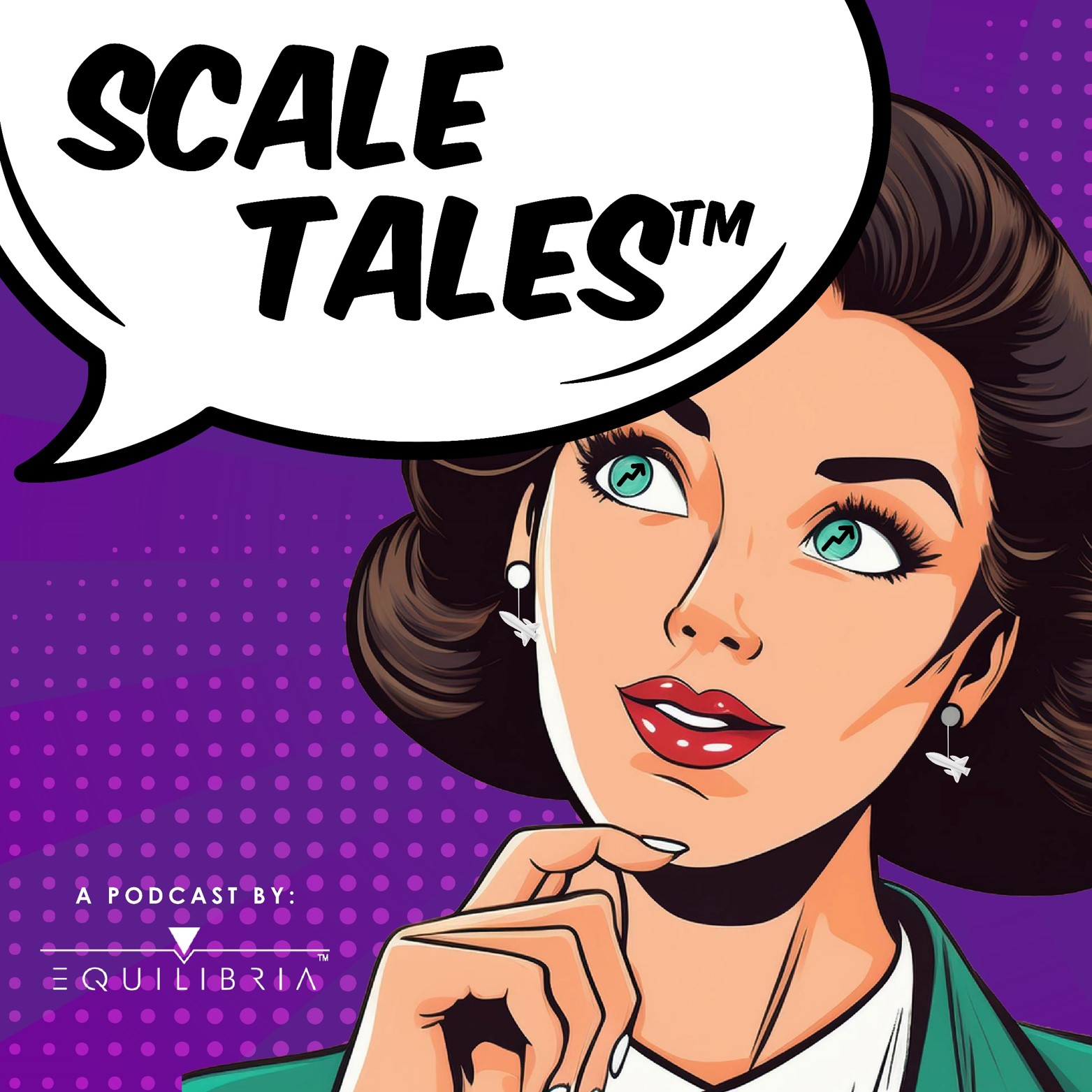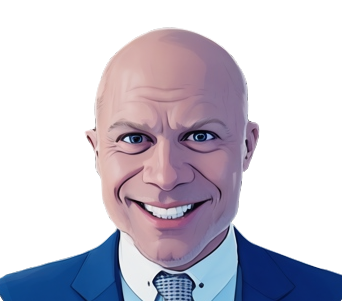Transcript
This podcast is brought to you by Equilibria, Inc. Did you know you can earn PDUs From listening to this show? It’s easy, accessible and submitted directly to PMI. Keep listening to learn more.
Equilibria provides training to assist fast-growing companies to increase capacity and cash flow while operating at maximum performance. As a founder, leader or project manager you know all too well that chaotic work environments aren’t sustainable. Visit EQBsystems.com to sign up for a free discovery call and start flowing today! EQBsystems.com.

Welcome to Scale Tales – the business storytelling podcast where entrepreneurs, executives and experts share firsthand accounts of those magical moments when they achieved something bigger than even they could have imagined.
I’m Alicia Butler Pierre and oh are you in for an intellectual treat! Let me set the scene. This next scale tale begins in Connecticut, a small state in the northeastern part of the U.S. It’s the 1980s. Big hair and brightly colored clothes are in style and so are small sportscars. More women have entered the workplace, and these things called computers are starting to become common inside offices.
Enter our next guest. He’s a budding young engineer, eager to make his mark in the burgeoning tech scene. Little does he know he’s about to go on one long, fantastic voyage that will have him transitioning from software coder to international project manager to entrepreneur, author, and highly sought after corporate educator. This is a two-part interview.
In this first part, you’ll first hear about his background to give you an idea of the man behind all the wisdom.
This is Ep. 42: How Dr. Frank Harper Trained Project Managers to Become Better Leaders and Executives in Over 65 Countries, Part 1.

Hello, I’m Dr. Frank Harper Jr., corporate educator and transformation architect. I currently reside in Atlanta, Georgia and this is my scale tale.
It started back in 1983. I was working as a lead systems analyst for the corporate headquarters of Pitney Bowes. At the same time I was moonlighting as an IT project manager with a startup company called CAT Incorporated. Computer Assisted Training and Technology. We were building the world’s first online real time PC-based financial accounting system for small to medium sized businesses.
To support the development, we did stand up training and computer based training as the name indicated. All I wanted to do was write code. I didn’t want to train, I didn’t want to do any of that stuff. But the president of the company who happened to be my mentor, he convinced me. Well, actually he tricked me into training. We would do training for all of the major corporations. There was one assignment in particular for the Hartford Insurance Group. We were teaching structure analysis and design techniques.
On this particular assignment he asked me to come with him to sort of audit the class just to sharpen my skills. And so I get to the class and he does a bang out job, okay. All of a sudden, we’re sitting down for dinner. Now what I also have to add is that I lived in one of his apartments. So, I knew his family very, very well. He was the epitome of a mentor.
A mentor who was about to make Dr. Harper an offer he wanted to refuse.
He said his wife is having some issues and he has to leave. And I said okay. And he said, “That means you have to teach the class.” what? I have to do what? ”No, you’ll do fine,” You do this stuff, In your sleep. You just have to work on your presentation skills” Now this was a four-day class, started at 9 o’clock in the morning and went all the way to five o’clock in the evening. Now this was a four-day class, started at 9 o’clock in the morning and went all the way to five o’clock in the evening.
To say Dr. Harper was nervous was an understatement, but he accepted the challenge.
What happens is the people that are sitting in that room, they probably have more experience than you do in that particular subject matter and they will be quick to shut you off if you say something that is not true. Something that they can’t take back to their workplace. So I Put on my big boy boots, put on my little presentation hat, and I started delivering. I started delivering and before I knew it, the class was over. A lot of the students, were really nice.
They were real nice to say,
“There were things in there that you talked about that we weren’t aware of.”
One of the things I learned about corporate education is that the best way to capture the audience is to talk about your experiences. That takes the theoretical aspect of what you’re presenting and makes it real, and they can make the connection. And so wherever I went, even if my job was not a corporate education, the focus was always on training my people, making sure that they can be very, very productive.
Those initial training experiences laid the groundwork for what would soon lead Dr. Harper to leave CAT Incorporated and embark upon an interesting journey steeped in training and corporate education. But he was never far removed from technology.
We had the founding investors of DEC come and they were going to take us public, but we failed the financial audit. Now that’s another tale, but it taught me something about financial auditing, overstating of the books, et cetera, we still had a couple of investors that wanted to invest in because they liked the product.
There was a gentleman that flew in from Germany that stayed with me because I was the vice president of research and development. All product development was in my hands. And so I had to show this guy how great this product was. But in showing him, I had to teach him. I had to teach him, this is the approach, this is the methods. And I never forget, once he got it and he was able to see all the functionality, he let out this great big yell.
He said,
By Jove, I think I’ve got it! This is excellent!”
So we passed that litmus test. Now it’s time to do the financials. And that’s where the ball dropped. But anyway, my point is that two of the gentlemen still wanted to fund us, but we needed $5 million. Went to the bank. Bank says, well, listen, if you gave a million, we still couldn’t get what we needed to take it forward.
The year was 1988. When Dr. Harper realized that CAT Incorporated would not receive the funding it needed to continue operating, he not only left the company, but the entire state. Where was he headed? Over 1,000 miles south along the eastern coast of the U.S. to Atlanta, GA.
Why did I move to Atlanta, Georgia? Because for three years in a row, researching the Wall Street Journal, it said that Atlanta was the number one city to start a business. The Atlanta market…
Dr. Harper took a friend up on his offer to live with he and his growing family to help him establish roots in this new city. This also gave him the time he needed to research the Atlanta job market, understand who the players were in the technology space, and network. Soon, he started his own business.

The name of my company was Intelligent System Services Corp. I worked out an agreement with CAT Incorporated where I could get ownership of the source code. I modified the source code and sold a package, what I called AIM.
It was Automated Intelligent Management Information System. And I sold it to small businesses all around the country. Eventually I had a write up done by a major networking company and that write up got published and sent to what was called the Atlanta Tribune here in Atlanta, Georgia. I was one of their first front page stories. They talked about the uniqueness of the product, the uniqueness of the training.
What that experience told me was that being a market research, advocate that I need to take that and run with it. And so I started to research small business, see if in fact, are they ready for that product and what would they be willing to pay for it? Well, after researching and talking to about 300 people, I realized that I couldn’t make a living with that. They were not willing to spend $10,000 for a turnkey solution. One of the clients in Fort Worth, Texas, never forget, in 1990, like the package wanted me to convert it to a construction. He bought the whole package. My first million-dollar payday.
Now I’ve got money, this is the second time that I was a millionaire on paper because this one was a little bit more real because I had dollars and so I decided to look at other opportunities I got invited to the International Congress of Art, Science and Communication in Lisbon, Portugal.
I was there for about 10 days and I started talking. I got an impromptu conversation about business ecosystems and how important it was for businesses to understand that they are not just a self contained entity, they are a part of the environment that they belong to. At that time, I was invited to Nigeria by the Nigerian delegation that had attended that session and had heard my speech. Now mind you, I wasn’t on the schedule. They just started talking and I just…
My personality I get a little passionate about things and the teacher comes out of me. They decided we need engineers like you in Nigeria. And so from 1990 to 1993, I worked on and off as a contractor for one of the largest oil companies. What stood out, is that I didn’t bring any resources from the United States.
I used all Nigerian resources. And the challenge to them was that managing the various projects, okay, the project or program that I was working on was a $2.2 billion modernization effort. They had experienced everything that you could think of that would go wrong with a project. Cost budget overruns, schedule slippages, missing deadlines, I introduced them to earned value management.
Earned value management or EVM is a project management technique for measuring a project’s performance and progress. This is done by measuring things like the project’s scope, time, and costs. You may be wondering, how can you measure something like a project’s scope. Well, that’s the beauty of EVM. It offers a way to quantify factors like a project’s scope in order to forecast potential issues with a project. This gives project managers the ability to be proactive in resolving those forecasted issues before they become a reality.
I worked through the various leaders to have everyone working on that project to restate their budgets and do $25,000 work packages. So whether it was a hundred million dollar project or whether it was a $100,000 project, whether you’re building some type of refinery or you’re putting in the system, all the budgets had to be restated. So every budget had work packages of $25,000. And they said, “Well, why $25,000?” I said, because projects don’t fail, people do! That’s the first lesson. Second, it’s a whole lot easier to catch a project that is slipping. At $25,000 as opposed to $100,000, because based upon the environment that I see here, these projects slip every day.
There was anywhere from 800 to 1000 projects in terms of human resources, people resources. Once they understood the benefit of earned value management. I got the same kind of reaction that I got when I was showing that gentleman about the accounting system. They said it makes sense, so they restructured the entire project.
And the results spoke for itself. By implementing earned value management and breaking down projects with large budgets into smaller projects with a budget cap of $25,000 USD, Dr. Harper reported that…

The success rate of the project went from 25% to over 92%. That’s the first thing. The second thing is that we stayed over $800 million. The third thing is that based upon the revenue that they were generating from these improved processes is that their revenue uptick was over $5 billion and growing. That again brought me back into the training aspect. The project management aspect. I came back to the States.
Remember, before working in Nigeria, Dr. Harper sold the software component of his company, Intelligent System Services. Once he arrived back to Atlanta, he decided to do a brand refresh with new offerings.
Now we’ve transformed back into what I was comfortable with, training, consulting and advisory. And so that’s where I’ve been now from 1993 to the year 2025.
And what a journey it’s been! Along the way, he received his doctorate in Administration and Management in 2005. By leaning more into training, consulting, and advisory services, Dr. Harper’s reach spans across the globe.
I can’t give a specific number, but I can tell you this. I’ve trained project managers, PMPs, governance professionals in over 65 countries worldwide. I’ve done that through corporate education training, but also for the past 12 years. I’ve been working as a university officer, also as a professor with a university based in Switzerland that has. It’s a corporate education university. And for those who may not be familiar with corporate education, corporate university. I used to work for McDonald’s headquarters.
They had a corporate university called Hamburger University. And the difference between the corporate university and traditional university is traditional universities. Everything is to edify the individual. Whereas with corporate universities, it’s all focused on improving the organization. So I’ve been working with Cambridge Corporate University in Luzerne, Switzerland.
My students are leaders, executives from over 25 countries worldwide. They come to the school with business problems. My classes are not only a training session, but there’s also coaching and mentoring. I since expanded my client portfolio to working with SBS Swiss School of Management and also the Swiss UMF University of Applied Science Institute where I teach such topics as corporate social responsibility and international business law.
I’m not a lawyer. However, I understand business law from a layman’s perspective. And that’s what these executives need to understand. I also teach global strategy, advanced project management and artificial intelligence, digital business leadership and cross functional leadership.
Impressive, right? See, I told you – Dr. Harper is a wealth of information. Now that you know more about his professional journey and what led him to becoming a corporate educator and trainer, we’ll switch gears and dive deeper into the work he does currently in project management. And trust me, he has a lot to say!
Are you a certified Project Management Professional? Just imagine, you can literally listen and learn while you earn credits. Yes, even while you’re taking a long walk, driving to or from work, even while you’re on an airplane. The good thing about our podcast episodes is that you don’t have to watch them in order to earn your PDUs.
In three easy steps – Visit ScaleTalesPodcast.com, sign up for a membership, take a short quiz and we’ll submit your credits to PMI. Yes, it’s really that simple and all at a price that makes this information accessible wherever you are. No gimmicks, no games. It’s really that simple! ScaleTalesPodcast.com.
Welcome back! Before the break, you heard the incredible start of Dr. Frank Harper’s scale tale. It’s a journey that’s led him around the world and back. Along that journey, he transitioned from being a software coder to a prolific corporate educator and trainer of project managers in over 65 countries! He earned his doctorate, has worked as a C-suite technology executive in different organizations, and has even written several books. In one of those books he coined the term, “strategic hustler.”
What is a strategic hustler? Well, you’re about to discover that and why Dr. Harper says that every project manager should become a strategic hustler. Speaking of project managers, he believes that term, “project manager” is actually a misnomer in the 21st century. Clearly he’s not afraid of controversy.
Here’s Dr. Harper.
One thing I learned about corporate education, as opposed to traditional education. You have people in that class who are just as experienced, even more experienced. And they don’t care whether you are your first teaching assignment or your 50th teaching assignment. They don’t want to waste their time.
I’ve sort of found a niche over the years where I focus on project managers as senior executives. Now the reason why I focused on that niche…I’m going to fast forward and talk about my post-doctorate stories studies. I earned my Ph.D. in administration and management and my dissertation focused on effective leadership for enterprise commerce management. And I decided to do a quantitative study. I developed a questionnaire.
That questionnaire was endorsed by the Project Management Institute and the Leadership and Management Group of CIO Magazine. I then interview close to over 1500 respondents because PMI took the questionnaire and put it on their website and CIO magazine did the same for theirs. So I got a really good response. About 38% of the respondents were statistically relevant which is great. So, I wrote my dissertation and it was well over 330 pages and glowing review and defended it very very well. But I always talked about leadership from a project management perspective. And from that study what I realized is that project management was the strategic enabler.
That phrase, “strategic enabler” paved the way for Dr. Harper’s career as an author, executive leader, and project manager. His other phrase, “strategic hustler,” would soon follow.
Two years later PMI is looking for volunteers for a seminal research project entitled “Project Managers as Senior Executives.” And one of the areas for further study that I had wrote my dissertation fell right into that wheelhouse and so I volunteered I was the only researcher from the United States. We had researchers from all over the world. It was a two year study and it was a joint effort between the Project Management Institute and the S.K. Lilly School of Management in France which at that time was the largest PMI accredited school in France.
That study really just sort of spark plug my creative juices where now I focus on any project manager wants to be a senior executive.
This makes sense considering Dr. Harper’s own career up to this point as a senior executive and project manager.

I not only have the theoretical but my career progression has gone from a project manager. I’ve been a CIO, I’ve been a deputy CIO, I’ve been a project process excellent director. I was the CIO for at that time the fastest growing educational company in the United Kingdom according to Inc. 500 Europe magazine.
My passion is really centered around taking project managers and not getting them to think outside the box. But I’m telling them break the box. And so I talk about various practices that I developed over the years. My book is entitled A.G.I.L.E. L.E.A.D.E.R.S.H.I.P. with a G.R.I.P.: A 21st century journey from Street Hustler to Strategic Hustler. And what I do is I look at leadership from a project leadership perspective in three areas, i.e., mindsets, skill sets and tool sets. Mindsets have to be flexible, skill sets have to be collaborative, and tool sets have to allow you to stay in control.
What I’m currently doing right now as a corporate educator. I work for a number of international universities. I sit on the board of international universities in Singapore, in Switzerland. I’m the chair of a dissertation committee for what’s called Swiss UMF University of Applied Sciences Institute. And also I teach a number of courses. I teach Agile Advanced
Project Management and Artificial intelligence. I teach corporate social responsibility, Global strategy, Digital business leadership, business transformation.
Combined, these disciplines form a unique concept that Dr. Harper branded. It’s the one I alluded to earlier – the Strategic Hustler. This, as you’ll hear him describe, goes beyond simply being a project manager or project leader in the 21st Century.
A Strategic Hustler is a multidimensional innovation futurist.
I choose the term multi-dimensional because we live in a world that requires organizations to be boundaryless. Innovation has to be limitless. Digitization must be unbounded and iteration must be. Relentless. And that’s because the world that we live in is. You’ve heard the term VUCA, if you haven’t, VUCA stands for volatility to change, there’s uncertainty.
With that uncertainty there’s complexity. And with complexity there’s ambiguity. And so that strategic hustler has to have that multi dimensional aspect to it because the solutions that are required in this day and age are transformation. But transformation is the higher order.
Over the years what happens is you have an optimization projects, then you have modernization projects and then you have transformation projects. Transformation consists of eight disciplines. You have the strategic disciplines, that is strategy management, value management and risk management. Said another way, what is my transformation ambition, what its value is going to bring to me and what are the risks?
What takes that strategy and turns it into action is you have to have a strong organizational program and project management capability because it takes the strategy components and it links it to such disciplines as business process management, IT transformation management, organizational change management and training, and competency management. So those are the eight disciplines that are needed to have successful transformations. And so that’s why I use the term multi dimensional.
The project manager, the project leader of the 21st century doesn’t have to know all of those different disciplines. But there are key answers, key questions that the project leader should ask. And notice I’m using the term project leader. I’m getting away from project manager. When I talk about project leader. It can be not only the, the person that is the designated project leader for the project, but that also includes your executive sponsor. They have to be the project leader. Those are sort of the key components. And then there’s a whole bunch of disciplines that I talk about in each one of those eight areas.
This concludes part 1 of our two-part interview with Dr. Frank Harper. If it seems like he’s starting to share a lot of information with you, you’re right! And, believe it or not, he has so much more to share. In fact, here’s a peek of what’s to come:
“When you look at methodologies, from a project management standpoint, only 35% of projects are executed successfully. And when you look at the methodology, it tells you, okay, you need to do this, you need to dot the I, you need to cross the T, et cetera.
But a framework gives you a consistent, coherent approach to solving the problem. But then based upon the industry, you have to use that framework and you have to customize how you use that framework to your particular organization.”
Yep, we’re going to talk about what it really takes to manage and lead projects in increasing complexity, globalization, and rapid change. Make sure you subscribe to the Scale Tales podcast so that you don’t miss when part two becomes available. Dr. Harper will explain what you just heard him say as well as other practical tips for leading and managing projects of all sizes in an age of AI and digitization. He’s already shared a number of resources that we’ll have available in this episode’s show notes at ScaleTalesPodcast.com.
And there will be even more resources as well as a recap of key lessons learned in part two.
Thank you for Listening! If you learned something valuable from this episode, please leave us a five-star rating and review wherever you’re listening.

I’m Alicia Butler Pierre and I produced and narrated this episode. Audio editing by Olanrewaju Adeyemo. That German male voiceover you heard earlier was also me. Additional male voiceover by Clarence Levy III. Music production and original score by Sabor! Music Enterprises. Video editing by Gladiola Films. Show notes by Hashim Tale.
You’ve been listening to Scale Tales, a podcast by Equilibria, Inc.












